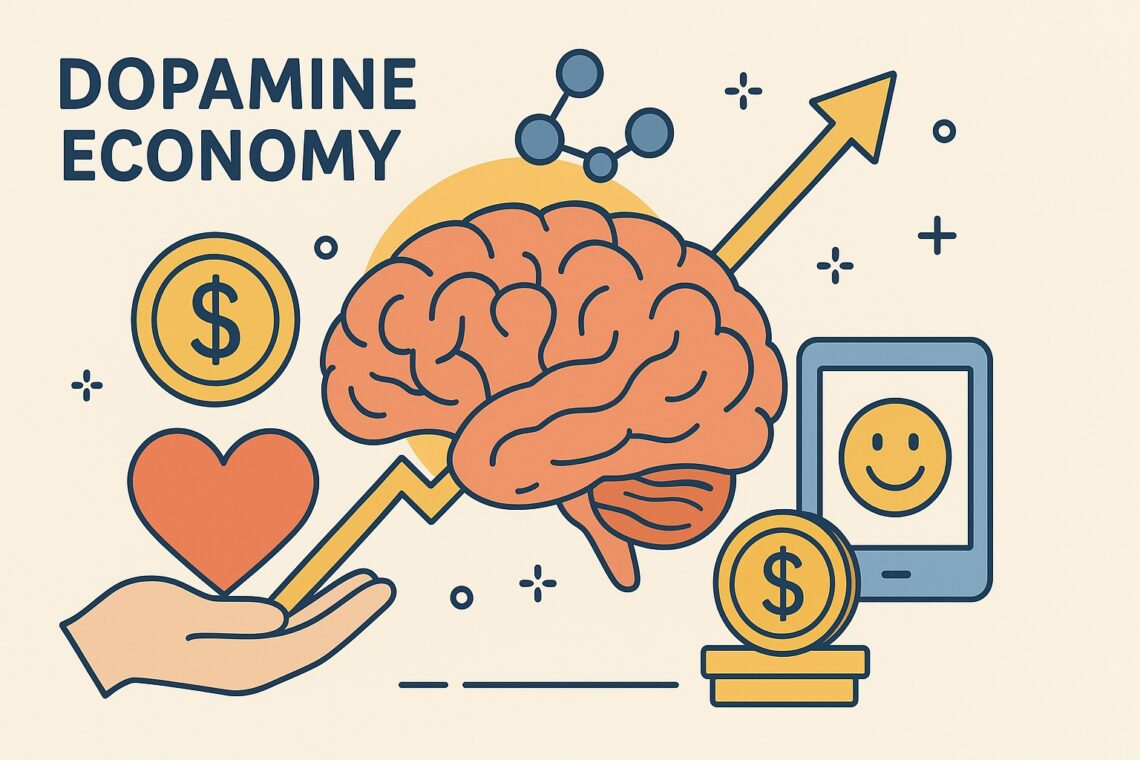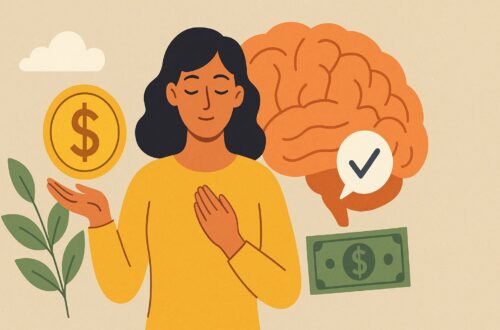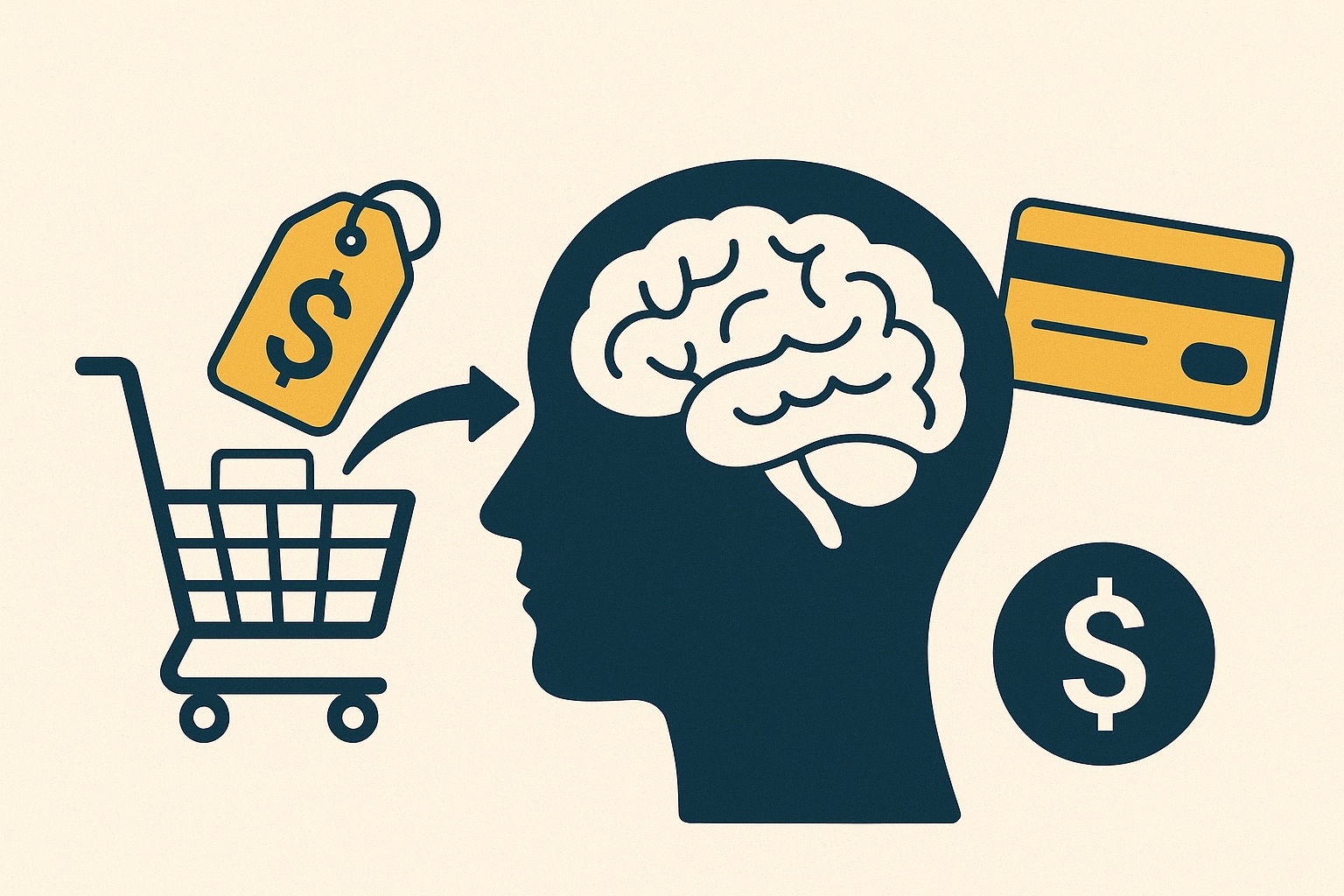Your brain was never built for modern markets. Yet every time you swipe to buy a stock, watch a green candle rise, or hear that satisfying notification ping, it releases a chemical whisper: DOPAMINE. It’s the same molecule that fires when someone likes your post, wins a game, or gets an unexpected message. Now, it’s also the invisible currency powering the dopamine economy.
Trading apps like Robinhood, Binance, and eToro have turned investing into a gamified experience, a sleek, scrollable playground of instant gratification. Every price flash, every confetti animation, every upward arrow is engineered to activate your brain’s reward circuits. The more often you trade, the more the platform wins, even if your portfolio doesn’t.
This isn’t accidental design; it’s behavioral engineering. The lines between entertainment, gaming, and investing have blurred. You’re not just managing money anymore; you’re managing neurochemistry. Behind every impulse trade lies a tug-of-war between logic and emotion, discipline and dopamine.
In this article, we’ll explore how trading apps subtly manipulate our decision-making, why our brains find volatility irresistible, and how to recognize when you’re being chemically nudged toward risk. Understanding the dopamine economy isn’t just about protecting your wallet; it’s about reclaiming your focus, your discipline, and your ability to think long-term in a world designed to keep you hooked short-term.
Table of Contents
TogglePrelude: The Market in Your Pocket in the Dopamine Economy
A decade ago, investing meant waiting for business hours, calling brokers, or flipping through financial newspapers. Today, the market fits in your pocket. Smartphones have transformed trading into a constant, 24/7 interaction, blurring the line between leisure and finance. Apps like Robinhood, Binance, and eToro have made it effortless to execute trades with a tap, swipe, or scroll. What once felt like a deliberate, calculated action is now an almost subconscious habit.
This constant access isn’t neutral. Every notification, price update, and app animation is designed to capture attention and trigger a small burst of reward in your brain. The more often you engage, the stronger the pull. Suddenly, checking your portfolio becomes as habitual as checking social media, a daily, dopamine-fueled ritual.
The irony is striking: these apps were marketed as tools for empowerment, promising accessibility and financial freedom. Yet beneath the surface lies a carefully crafted experience engineered to maximize engagement. Your pocket-sized market is less a neutral interface and more a psychological playground. It’s here, in this intimate, always-available space, that the dopamine economy begins to take hold, conditioning behavior and subtly nudging decisions long before rational analysis can weigh in.
The Brain’s Currency: Understanding Dopamine in Trading Apps
Dopamine is often called the brain’s reward chemical, but its role in human behavior goes far beyond pleasure. It is the signal that drives motivation, focus, and action. When we anticipate a reward, dopamine levels spike; the outcome itself is secondary. This subtle distinction explains why uncertainty can feel more addictive than guaranteed gains.
In the context of trading apps, every price movement, notification, or small profit triggers a dopamine response. Your brain interprets these signals as meaningful, even if the financial impact is minor. This process creates a feedback loop: the brain craves more signals, and the app provides them in bite-sized doses. The result is heightened engagement and impulsive decision-making.
Modern behavioral finance recognizes this connection between neurochemistry and investing patterns. Traders who understand the dopamine response can identify why they check their portfolios repeatedly, why micro-trades feel compelling, and why volatile markets create emotional highs similar to gambling, a pattern closely related to everyday spending behaviors. Learn more.
The dopamine economy thrives on this biological mechanism. Platforms are designed to exploit anticipation and reward cycles; the brain becomes the product, and attention becomes the currency. Recognizing dopamine as a driving force is the first step toward reclaiming control. By understanding how your brain responds to cues, you can separate impulse from strategy and make decisions that align with long-term financial goals instead of short-term chemical rewards.
The Architecture of Addiction: Inside the Design of Trading Platforms
Trading apps are more than financial tools; they are carefully engineered experiences that tap directly into human psychology. Every color, animation, and notification is designed to maximize engagement and trigger the brain’s reward system. These platforms borrow techniques from social media and gaming, turning investing into a behavioral loop that feels effortless but is highly manipulative.
Confetti animations after a successful trade, badges for reaching milestones, and instant notifications of portfolio changes create micro-rewards that mimic the sensation of winning. Bright green numbers signal gains, red numbers signal losses; these simple cues guide emotional responses, often overriding rational thinking. Swiping, tapping, and scrolling mimic gaming mechanics, creating a tactile sense of control while subtly keeping the user engaged longer.
The app interface also encourages micro-decisions: small trades, fractional shares, and split-second orders. Each action is designed to feel manageable and low-risk, yet collectively, they create a pattern of constant engagement. Push notifications, personalized alerts, and leaderboard rankings add a social element, increasing the pressure to participate and compare performance.
In this environment, the line between entertainment and investing disappears. The architecture of trading apps is not neutral; it is a psychological ecosystem that leverages dopamine, anticipation, and social validation. Recognizing these design elements is essential for anyone who wants to trade consciously rather than being led by engineered impulses in the dopamine economy.
Micro-Doses of Risk: How Tiny Trades Drive Engagement
Trading apps often break large financial decisions into tiny, digestible actions. Buying a fractional share, investing a few dollars, or executing a quick trade may feel harmless, but these micro-doses of risk are powerful triggers for the brain. Each small action generates a dopamine response, reinforcing engagement without requiring significant capital or conscious deliberation.
This design exploits a fundamental principle of neuroscience: the brain reacts more strongly to uncertainty and anticipation than to predictable outcomes. Even a small potential gain can create an emotional spike similar to that of gambling. Repeated micro-trades condition the brain to associate action with reward, making users more likely to continue trading compulsively.
The effect is cumulative: small wins and minor losses keep the mind engaged while reinforcing a sense of control. Traders often feel strategic and deliberate, yet the underlying driver is the reward system responding to frequent, variable cues. This combination of low stakes and high emotional response amplifies impulsive behavior, subtly reshaping decision-making over time. or a deeper look at dopamine’s central role in economic decision-making, see this study.
In the dopamine economy, micro-doses of risk make the act of trading feel effortless while keeping the brain in a constant loop of anticipation and reward. Recognizing this pattern allows traders to separate genuine strategy from chemically induced compulsion.
The Illusion of Control: When Every Swipe Feels Like Strategy
One of the most powerful psychological effects trading apps exploit is the illusion of control. The interface makes decision-making feel immediate, tactile, and impactful. Swiping to buy, tapping to sell, and monitoring live price movements all create the perception that users are actively shaping outcomes. Yet in reality, the markets remain unpredictable, governed by forces far beyond individual control.
This perceived control amplifies engagement. When traders believe their actions matter, the dopamine system rewards them with a sense of competence and mastery. Even random or minor outcomes can feel like a direct result of skill, reinforcing confidence and encouraging further activity. Behavioral finance calls this phenomenon control bias: the tendency to overestimate influence in situations governed by chance.
Gamified elements such as progress trackers, streaks, and achievement badges reinforce this effect. Every swipe, trade, or portfolio adjustment is designed to feel meaningful, while the platform subtly encourages repeated engagement. Social comparisons add another layer; leaderboards and community highlights suggest that skillful trading is both observable and attainable, strengthening the illusion.
Understanding the illusion of control is critical for mindful investing. By recognizing that perceived influence is often a neurological and design-driven effect, traders can pause, assess, and make intentional decisions instead of reacting impulsively to dopamine signals in the dopamine economy.
Variable Rewards and the “Maybe Money” Effect
A key driver of engagement in trading apps is the principle of variable rewards. Unlike predictable outcomes, variable rewards deliver gains, notifications, or positive feedback at irregular intervals. The uncertainty of when a reward might occur creates a powerful psychological pull, keeping users returning again and again. This is the essence of the “maybe money” effect: the brain becomes addicted not to consistent profits, but to the possibility of them.
This mechanism mirrors the psychology behind gambling. Slot machines, loot boxes, and mobile games use similar reinforcement schedules. The unpredictability of the outcome triggers dopamine spikes, even if the reward is small or infrequent. In trading, micro-wins, sudden price jumps, or unexpected notifications function the same way; each instance reinforces engagement and strengthens the compulsion to act.
Variable rewards also exploit human optimism bias, a mechanism that not only affects trading but also shapes everyday spending habits. Discover more.
Traders naturally overestimate the likelihood of success, imagining the next trade will yield a significant gain. The combination of uncertainty and anticipation magnifies emotional investment, sometimes leading to impulsive decisions or riskier behavior than would occur in traditional investing.
Understanding the “maybe money” effect allows traders to step back from constant engagement and evaluate decisions rationally. Recognizing that dopamine, not skill or insight, often drives behavior is a crucial step toward making intentional, long-term financial choices in the dopamine economy.
The Social Dopamine Loop: Leaderboards, Memes, and Market Validation
Trading apps are not just solo experiences; they exist within a larger social ecosystem. Online forums, chat groups, and in-app leaderboards create constant social feedback, amplifying dopamine-driven engagement. Every comment, like, or share acts as a social reward, reinforcing behavior and encouraging users to trade more frequently.
Leaderboards rank traders by performance, creating visible competition. Users derive a sense of validation when their trades or portfolios appear near the top, triggering dopamine spikes similar to financial wins. Even minor recognition, such as reaching a new rank or receiving positive community feedback, reinforces the desire to act again.
Memes and trending market narratives provide emotional cues, cultural signals, and shared experiences that validate decisions. Following the crowd becomes rewarding not just financially, but socially. The brain equates participation with belonging, strengthening the loop of anticipation and reward.
Market validation through social channels encourages impulsive behavior. Traders may enter positions based on popularity or social proof rather than analysis, responding to dopamine-driven signals of inclusion and approval.
Understanding the social dopamine loop is essential for mindful investing. Recognizing the influence of peers, memes, and virtual recognition allows traders to separate genuine strategy from socially reinforced impulses in the dopamine economy.
The Cost of Constant Stimulation: Financial Burnout and Cognitive Depletion
The dopamine economy thrives on constant engagement, but this continuous stimulation comes with a hidden cost. Traders who interact with apps multiple times per day are subject to cognitive overload, emotional fatigue, and decision-making depletion. Each alert, price update, and micro-trade triggers the brain’s reward circuits, creating short-term excitement but long-term strain.
Cognitive depletion occurs when repeated, high-frequency decisions drain mental resources. In the dopamine economy, the brain is continuously primed for anticipation and reward; this keeps users alert but reduces the capacity for rational analysis. Traders may experience impulsive decisions, riskier behavior, and emotional swings as mental energy diminishes.
Financial burnout is another consequence. The pressure to stay connected, track market movements, and respond to social signals can turn investing into a stress-driven cycle. The dopamine economy encourages constant participation, making breaks feel unnatural or even anxiety-inducing. Over time, this creates emotional exhaustion, undermining long-term strategy and personal well-being.
Recognizing these effects is critical. By limiting notifications, scheduling deliberate trading windows, and prioritizing long-term decisions over immediate dopamine hits, traders can protect cognitive resources and maintain control in the dopamine economy.
Detoxing the Brain: Rewiring Your Financial Habits for Clarity
In the dopamine economy, the line between strategy and compulsion is often blurred. Trading apps are designed to trigger continuous dopamine responses, making impulsive behavior feel natural. To regain control, traders must consciously detox their brains and rewire financial habits.
One effective strategy is implementing dopamine breaks. Scheduling specific windows for checking portfolios or executing trades reduces constant stimulation and allows the brain to reset. This prevents micro-rewards from hijacking decision-making and restores the capacity for deliberate analysis.
Another approach is delayed execution. By adding a short pause before confirming trades, users create space to evaluate risks, potential gains, and emotional impulses. In the dopamine economy, even a few minutes of reflection can break cycles of compulsive behavior and reinforce strategic thinking.
Tracking emotions alongside financial performance is equally important. Logging how trades make you feel helps identify patterns of impulsivity driven by dopamine rather than rational assessment. Over time, this practice strengthens awareness and encourages conscious decision-making.
Finally, mindfulness techniques, such as focused breathing or visualization, can reduce the intensity of dopamine-driven cravings. By cultivating calmness and presence, traders can interact with the market intentionally rather than reacting to every alert or price fluctuation.
Detoxing the brain is not about avoiding the dopamine economy entirely; it is about participating on your terms and preserving both financial health and mental clarity.
Epilogue: Ethical UX and the Future of the Dopamine Economy
The rise of trading apps has created a new frontier: the dopamine economy. Platforms are no longer neutral tools; they are carefully designed environments that influence decisions, manipulate anticipation, and trigger emotional responses. As the market evolves, a critical question emerges: will financial user experience prioritize ethical design or continue exploiting human psychology for engagement?
Some developers are exploring ethical UX frameworks. These designs emphasize transparency, delayed gratification, and user education, helping traders make informed decisions without relying on dopamine-driven impulses. Features such as optional notifications, cool-down periods, and analytics focused on long-term performance rather than short-term wins can shift the focus from instant reward to sustained financial growth.
However, the allure of engagement-driven revenue remains strong. The dopamine economy creates profitable opportunities for platforms by keeping users active, checking portfolios, and making frequent trades. Without regulation or widespread adoption of ethical principles, apps may continue to prioritize psychological hooks over genuine financial empowerment.
Understanding the dopamine economy is the first step toward change. Traders who recognize the mechanisms at play can participate intentionally, resisting the pull of engineered compulsion. The future of financial UX will be shaped by both technology and user awareness; those who integrate ethical design with conscious behavior may redefine investing as a balanced, informed, and psychologically sustainable practice.
The dopamine economy is not going away, but how we engage with it will determine whether it becomes a tool for empowerment or exploitation.




